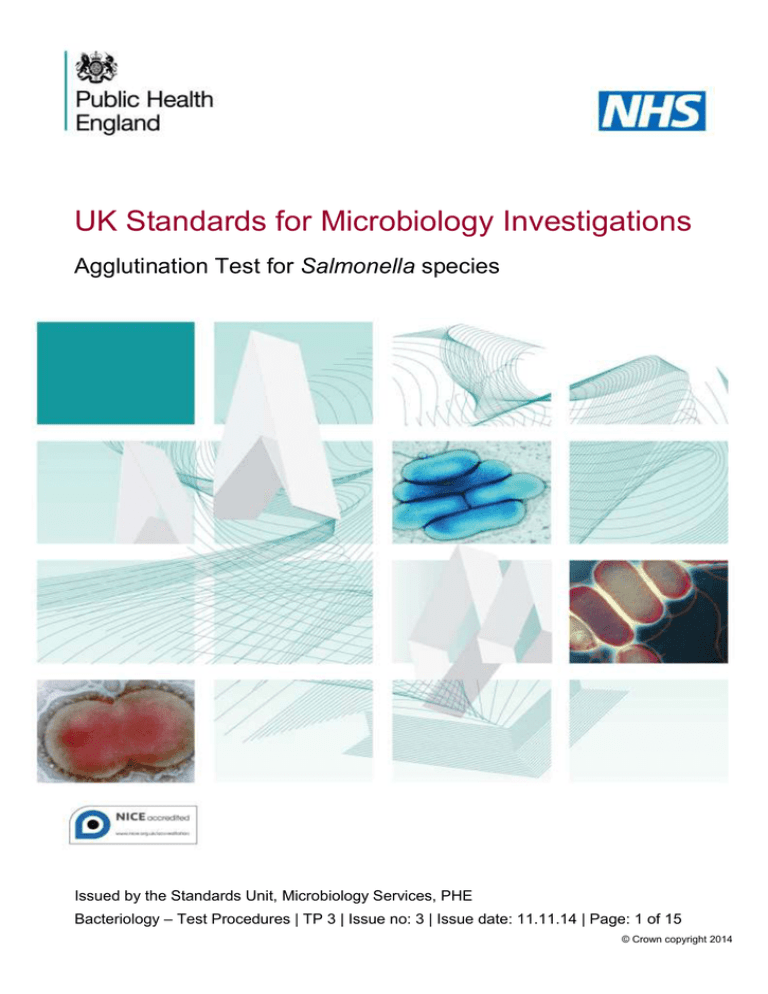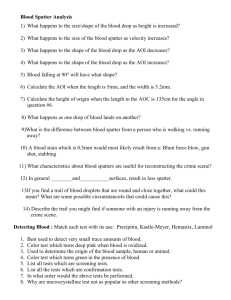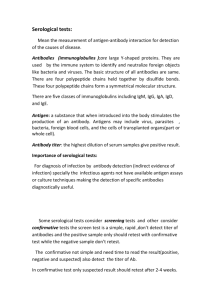TP 3i3 November 2014
advertisement

UK Standards for Microbiology Investigations Agglutination Test for Salmonella species Issued by the Standards Unit, Microbiology Services, PHE Bacteriology – Test Procedures | TP 3 | Issue no: 3 | Issue date: 11.11.14 | Page: 1 of 15 © Crown copyright 2014 Agglutination Test for Salmonella species Acknowledgments UK Standards for Microbiology Investigations (SMIs) are developed under the auspices of Public Health England (PHE) working in partnership with the National Health Service (NHS), Public Health Wales and with the professional organisations whose logos are displayed below and listed on the website https://www.gov.uk/ukstandards-for-microbiology-investigations-smi-quality-and-consistency-in-clinicallaboratories. SMIs are developed, reviewed and revised by various working groups which are overseen by a steering committee (see https://www.gov.uk/government/groups/standards-for-microbiology-investigationssteering-committee). The contributions of many individuals in clinical, specialist and reference laboratories who have provided information and comments during the development of this document are acknowledged. We are grateful to the Medical Editors for editing the medical content. For further information please contact us at: Standards Unit Microbiology Services Public Health England 61 Colindale Avenue London NW9 5EQ E-mail: standards@phe.gov.uk Website: https://www.gov.uk/uk-standards-for-microbiology-investigations-smi-qualityand-consistency-in-clinical-laboratories UK Standards for Microbiology Investigations are produced in association with: Logos correct at time of publishing. Bacteriology – Test Procedures | TP 3 | Issue no: 3 | Issue date: 11.11.14 | Page: 2 of 15 UK Standards for Microbiology Investigations | Issued by the Standards Unit, Public Health England Agglutination Test for Salmonella species Contents ACKNOWLEDGMENTS .......................................................................................................... 2 CONTENTS ............................................................................................................................. 3 AMENDMENT TABLE ............................................................................................................. 4 UK STANDARDS FOR MICROBIOLOGY INVESTIGATIONS: SCOPE AND PURPOSE ....... 5 SCOPE OF DOCUMENT ......................................................................................................... 8 INTRODUCTION ..................................................................................................................... 8 TECHNICAL INFORMATION/LIMITATIONS ........................................................................... 8 1 SAFETY CONSIDERATIONS ...................................................................................... 9 2 REAGENTS AND EQUIPMENT ................................................................................... 9 3 QUALITY CONTROL ORGANISMS .......................................................................... 10 4 PROCEDURE AND RESULTS................................................................................... 10 APPENDIX: AGGLUTINATION TEST FOR SALMONELLA SPECIES ................................. 13 REFERENCES ...................................................................................................................... 14 Bacteriology – Test Procedures | TP 3 | Issue no: 3 | Issue date: 11.11.14 | Page: 3 of 15 UK Standards for Microbiology Investigations | Issued by the Standards Unit, Public Health England Agglutination Test for Salmonella species Amendment Table Each SMI method has an individual record of amendments. The current amendments are listed on this page. The amendment history is available from standards@phe.gov.uk. New or revised documents should be controlled within the laboratory in accordance with the local quality management system. Amendment No/Date. 5/11.11.14 Issue no. discarded. 2.2 Insert Issue no. 3 Section(s) involved Amendment Whole document. Hyperlinks updated to gov.uk. Page 2. Updated logos added. Whole document. The title of the document has been updated. Safety considerations. This section has been updated regarding laboratory workers. Bacteriology – Test Procedures | TP 3 | Issue no: 3 | Issue date: 11.11.14 | Page: 4 of 15 UK Standards for Microbiology Investigations | Issued by the Standards Unit, Public Health England Agglutination Test for Salmonella species UK Standards for Microbiology Investigations: Scope and Purpose Users of SMIs SMIs are primarily intended as a general resource for practising professionals operating in the field of laboratory medicine and infection specialties in the UK. SMIs provide clinicians with information about the available test repertoire and the standard of laboratory services they should expect for the investigation of infection in their patients, as well as providing information that aids the electronic ordering of appropriate tests. SMIs provide commissioners of healthcare services with the appropriateness and standard of microbiology investigations they should be seeking as part of the clinical and public health care package for their population. Background to SMIs SMIs comprise a collection of recommended algorithms and procedures covering all stages of the investigative process in microbiology from the pre-analytical (clinical syndrome) stage to the analytical (laboratory testing) and post analytical (result interpretation and reporting) stages. Syndromic algorithms are supported by more detailed documents containing advice on the investigation of specific diseases and infections. Guidance notes cover the clinical background, differential diagnosis, and appropriate investigation of particular clinical conditions. Quality guidance notes describe laboratory processes which underpin quality, for example assay validation. Standardisation of the diagnostic process through the application of SMIs helps to assure the equivalence of investigation strategies in different laboratories across the UK and is essential for public health surveillance, research and development activities. Equal Partnership Working SMIs are developed in equal partnership with PHE, NHS, Royal College of Pathologists and professional societies. The list of participating societies may be found at https://www.gov.uk/uk-standards-formicrobiology-investigations-smi-quality-and-consistency-in-clinical-laboratories. Inclusion of a logo in an SMI indicates participation of the society in equal partnership and support for the objectives and process of preparing SMIs. Nominees of professional societies are members of the Steering Committee and Working Groups which develop SMIs. The views of nominees cannot be rigorously representative of the members of their nominating organisations nor the corporate views of their organisations. Nominees act as a conduit for two way reporting and dialogue. Representative views are sought through the consultation process. SMIs are developed, reviewed and updated through a wide consultation process. Microbiology is used as a generic term to include the two GMC-recognised specialties of Medical Microbiology (which includes Bacteriology, Mycology and Parasitology) and Medical Virology. Bacteriology – Test Procedures | TP 3 | Issue no: 3 | Issue date: 11.11.14 | Page: 5 of 15 UK Standards for Microbiology Investigations | Issued by the Standards Unit, Public Health England Agglutination Test for Salmonella species Quality Assurance NICE has accredited the process used by the SMI Working Groups to produce SMIs. The accreditation is applicable to all guidance produced since October 2009. The process for the development of SMIs is certified to ISO 9001:2008. SMIs represent a good standard of practice to which all clinical and public health microbiology laboratories in the UK are expected to work. SMIs are NICE accredited and represent neither minimum standards of practice nor the highest level of complex laboratory investigation possible. In using SMIs, laboratories should take account of local requirements and undertake additional investigations where appropriate. SMIs help laboratories to meet accreditation requirements by promoting high quality practices which are auditable. SMIs also provide a reference point for method development. The performance of SMIs depends on competent staff and appropriate quality reagents and equipment. Laboratories should ensure that all commercial and in-house tests have been validated and shown to be fit for purpose. Laboratories should participate in external quality assessment schemes and undertake relevant internal quality control procedures. Patient and Public Involvement The SMI Working Groups are committed to patient and public involvement in the development of SMIs. By involving the public, health professionals, scientists and voluntary organisations the resulting SMI will be robust and meet the needs of the user. An opportunity is given to members of the public to contribute to consultations through our open access website. Information Governance and Equality PHE is a Caldicott compliant organisation. It seeks to take every possible precaution to prevent unauthorised disclosure of patient details and to ensure that patient-related records are kept under secure conditions. The development of SMIs are subject to PHE Equality objectives https://www.gov.uk/government/organisations/public-health-england/about/equalityand-diversity. The SMI Working Groups are committed to achieving the equality objectives by effective consultation with members of the public, partners, stakeholders and specialist interest groups. Legal Statement Whilst every care has been taken in the preparation of SMIs, PHE and any supporting organisation, shall, to the greatest extent possible under any applicable law, exclude liability for all losses, costs, claims, damages or expenses arising out of or connected with the use of an SMI or any information contained therein. If alterations are made to an SMI, it must be made clear where and by whom such changes have been made. The evidence base and microbial taxonomy for the SMI is as complete as possible at the time of issue. Any omissions and new material will be considered at the next review. These standards can only be superseded by revisions of the standard, legislative action, or by NICE accredited guidance. SMIs are Crown copyright which should be acknowledged where appropriate. Bacteriology – Test Procedures | TP 3 | Issue no: 3 | Issue date: 11.11.14 | Page: 6 of 15 UK Standards for Microbiology Investigations | Issued by the Standards Unit, Public Health England Agglutination Test for Salmonella species Suggested Citation for this Document Public Health England. (2014). Agglutination Test for Salmonella species. UK Standards for Microbiology Investigations. TP 3 Issue 3. https://www.gov.uk/ukstandards-for-microbiology-investigations-smi-quality-and-consistency-in-clinicallaboratories Bacteriology – Test Procedures | TP 3 | Issue no: 3 | Issue date: 11.11.14 | Page: 7 of 15 UK Standards for Microbiology Investigations | Issued by the Standards Unit, Public Health England Agglutination Test for Salmonella species Scope of Document Agglutination tests are used to test an unknown organism against known antisera. They are used for example, in the serotyping of Salmonella species and serotyping of other organisms such as the Lancefield grouping of streptococci and in the differentiation of Staphylococcus aureus from other species of staphylococci1-3. This SMI should be used in conjunction with other SMIs. Introduction Bacteria, provided they form stable suspensions in saline, can be agglutinated directly by antibody. Bacterial agglutination tests may be performed on a slide, in microtitre tray wells or in tubes. Tube agglutination tests are usually more sensitive than slide tests as they require a longer incubation period which allows more antigen and antibody to interact. They are equally expensive due to the number of dilutions and large amounts of antigen required. Slide agglutination tests are simple to use, requires no equipment and is rapid. Microtitre trays may be used as they are easier to perform; saves time and space as well as reduces the volume of antisera used4. Standard bacterial suspensions and antisera may be obtained commercially. Latex agglutination preparations are available and manufacturers’ recommendations should be followed. Technical Information/Limitations For slide agglutinations, the test cannot be performed if the bacterial suspension is granular, autoagglutinates or is sticky as the result will be uninterpretable. For slide agglutinations, growth on solid media is not optimal for the formation of flagella. False negative results may be obtained with H antisera. Inoculation of the pure culture to a wet nutrient agar slope will aid flagellum formation. Isolates that show no agglutination must be identified by other methods. If using commercially manufactured antisera, check suitability of use for all methods. The limitation to these commercially manufactured agglutination preparations is that they have limited shelf lives that place increased demands on procurement and distribution systems. Bacteriology – Test Procedures | TP 3 | Issue no: 3 | Issue date: 11.11.14 | Page: 8 of 15 UK Standards for Microbiology Investigations | Issued by the Standards Unit, Public Health England Agglutination Test for Salmonella species Safety Considerations5-21 1 Most Salmonella species are Hazard Group 2 with important exceptions including Salmonella enterica serovar Typhi and Salmonella enterica serovar Paratyphi A, B and C. All work on S. Typhi and S. Paratyphi A, B and C must be performed under Containment level 3 conditions. S. Typhi and S. Paratyphi A, B and C cause severe and sometimes fatal disease. Laboratory acquired infections have been reported22. S. Typhi vaccines are available; guidance is available from the Department of Health23. Immunisation of laboratory workers may therefore: Protect the individual and their family from an occupationally-acquired infection Protect patients and service users, including vulnerable patients who may not respond well to their own immunisation Protect other healthcare and laboratory staff Allow for the efficient running of services without disruption Appropriate personal protective equipment (PPE) and techniques designed to minimise exposure of the laboratory workers should be worn and adhered to at all time. The most effective method for preventing laboratory-acquired infections is the adoption of safe working practices. All work likely to generate aerosols must be performed in a microbiological safety cabinet. For slide agglutination and microtitre test, all slides/plates should be discarded appropriately after reading of results to avoid contaminating the fingers or workbench with live bacterial suspensions24. Refer to current guidance on the safe handling of all organisms documented in this SMI. The above guidance should be supplemented with local COSHH and risk assessments. Compliance with postal and transport regulations is essential. 2 Reagents and Equipment 2.1 Slide Agglutination Known antisera Bacterial culture 0.85% sterile saline Glass slides Bacteriological straight wire/loop (preferably nichrome) or disposable alternative Bacteriology – Test Procedures | TP 3 | Issue no: 3 | Issue date: 11.11.14 | Page: 9 of 15 UK Standards for Microbiology Investigations | Issued by the Standards Unit, Public Health England Agglutination Test for Salmonella species 2.2 Microtitre Agglutination Somatic (O) antigen suspension Flagellar (H) antigen suspension Known antisera 1% formol saline U well microtitre plates 2.3 Tube Agglutination Somatic (O) antigen suspension Flagellar (H) antigen suspension Known antisera 0.85% saline 1% formol saline Glass tubes usually 75mm by 1cm Dreyer’s tubes H antigen 3 Quality Control Organisms Quality control organisms for tube and slide agglutinations Positive Control Homologous organism to the antiserum Negative Control Organism in saline only 4 Procedure and Results24 4.1 Preparations of O and H Suspensions For each organism inoculate two tubes of Brain Heart Infusion broth, one for O antigen and one for H antigen Incubate at 37°C for 4-5hr Dilute each suspension in formol saline so that there are approximately 109 bacteria/mL (McFarland Standard) 4.1.1 Preparation of O Suspensions Steam the O antigen broth culture at 100°C for 30 min Allow to cool and dilute with an equal volume of saline 4.1.2 Preparation of H Suspensions Add an equal volume of 1% formol saline to the H antigen broth culture Bacteriology – Test Procedures | TP 3 | Issue no: 3 | Issue date: 11.11.14 | Page: 10 of 15 UK Standards for Microbiology Investigations | Issued by the Standards Unit, Public Health England Agglutination Test for Salmonella species 4.2 Allow to stand overnight or can use straight away if possible (necessary) Microtitre Tray Test Procedure Add 25µL of saline to all 8 wells in a column in a microtitre tray Add 25µL of an antiserum to the top well and double dilute down to well 7. Discard the excess 25µL from well 7 instead of adding it to well 8 Well 8 contain saline only as an antigen control Add 25µL of respective O or H diluted antigen to all wells. Seal the microtitre plate The final dilutions are: Well: 1 2 3 4 5 6 7 8 Dilution: 1/10 1/20 1/40 1/80 1/160 1/320 1/640 0 Incubate the O antigens in an incubator at 50°C overnight before examining for agglutination Incubate the H antigens in a water bath at 50°C for 2hr before examining for agglutination Positive Result Agglutination of the suspension. Negative Result Suspension remains turbid. Antigen control well Suspension remains turbid. Note: Care must be taken to avoid shaking of the microtitre plates during and after incubation to allow settling of the antigen. 4.3 Slide Agglutination Test Procedure Place 2 drops of sterile saline on a divided slide and emulsify a colony in each to make a milky suspension or alternatively, place 2 drops of previously prepared milky suspension of the test organism in drops of saline on a slide. If auto-agglutination occurs or the suspension is rough in saline then discard the slide. The test can only be performed with smooth suspensions. Add a drop of antiserum to one suspension only, the other acts as the control, and mix by tilting the slide to and fro for 30-60 sec. Examine for agglutination (clumping) of the suspension (with antiserum) and clearing of the saline under a good light against a black background with the naked eye. Positive Result Agglutination of the suspension (clumping) Negative Result Suspension remains turbid Bacteriology – Test Procedures | TP 3 | Issue no: 3 | Issue date: 11.11.14 | Page: 11 of 15 UK Standards for Microbiology Investigations | Issued by the Standards Unit, Public Health England Agglutination Test for Salmonella species 4.4 Tube Agglutination Test Procedure Note: The O and H antigen tests are carried out in parallel. For each O and H antigen tested against each antiserum set up a row of seven tubes and add 0.4mL of saline to tubes 2 and 7 Add 0.2mL of 1/5 antiserum to tubes 1 and 2. Mix the contents of tube 2 and perform doubling dilutions to tube 6 and then discard 0.2mL instead of adding it to tube 7 Add 0.2mL of the respective bacterial O or H suspension to each tube The final dilutions are: Tube 1 2 3 4 5 6 7 Dilution 1/10 1/20 1/40 1/80 1/160 1/320 0 Incubate tests with O suspensions in a water-bath at 37°C for 4-6hr, then allow to stand overnight in a refrigerator Using a fine capillary pipette and starting from tube 7 and working backwards to tube 1, transfer the contents of each H tube to a Dreyer tube Incubate H tests for 2 - 4hr in a water-bath at (37°C) and read after standing on the bench for half an hour. For some bacteria, incubation at 50°C is preferable Examine each tube for agglutination of the bacterial suspension. If necessary, rotate the tube to swirl-up the granules from the deposit, but do not shake the tube Examine the control tube 7 without the serum to confirm that autoagglutination has not taken place. And if it has, disregard positive results in the other tubes The titre taken is the highest dilution with clearly visible agglutination For practical purposes, it is usual to set up a range of different O antisera at 1/20 and then titrate the positives. Positive Result Agglutination of the suspension Negative Result Suspension remains turbid Antigen control tube Suspension remains turbid Bacteriology – Test Procedures | TP 3 | Issue no: 3 | Issue date: 11.11.14 | Page: 12 of 15 UK Standards for Microbiology Investigations | Issued by the Standards Unit, Public Health England Agglutination Test for Salmonella species Appendix: Agglutination Test for Salmonella species Isolate discrete colony Inoculate 2 tubes of brain heart infusion broth for O or H antigen respectively and incubate at 37°C for 4-5hr Dilute each suspension to 109cfu/mL Steam the O antigen broth suspension at 100°C for 30 min Add equal volume of 1% formol Saline to the H suspension broth Allow to cool and dilute with an equal volume of saline Leave to stand overnight or use straight away if neccesary Microtitre tray test Tube agglutination Slide agglutination Add 25µL to column of 8 wells in a microtitre tray For each antigen, set up row of 7 tubes and add 0.4mL saline to tubes 2 and 7 Place 2 drops of sterile saline on a slide and emulsify the test organism colonies in it to make milky suspensions Add 25µL antiserum to well 1 Add 0.2mL of 1/5 antiserum to tubes 1 and 2 and mix Double dilute down to well 7 discarding excess 25µL from well 7 NB. Well 8 = control Carry out doubling dilutions from tubes 2-6 discarding remaining 0.2mL Add 25µL of O or H diluted antigen to all wells and seal plate Smooth suspension Add 0.2mL of either O or H suspension to each tube Incubate O suspension in a 37°C waterbath for 4-6hr and then leave in refrigerator overnight Transfer tube contents of H suspension into Dreyer tube, and incubate at 37°C in waterbath for 2-4hr O Antigen H Antigen Place in 50°C incubator over night Place in 50°C waterbath for 2hr Add a drop of antiserum to one suspension only and mix. The other acts as the control. Examine for agglutination Positive Agglutination of suspension Rough suspension or autoagglutination occurs Negative Suspension remains turbid The flowchart is for guidance only. Bacteriology – Test Procedures | TP 3 | Issue no: 3 | Issue date: 11.11.14 | Page: 13 of 15 UK Standards for Microbiology Investigations | Issued by the Standards Unit, Public Health England Discard slide Agglutination Test for Salmonella species References 1. Myrick BA, Ellner PD. Evaluation of the latex slide agglutination test for identification of Staphylococcus aureus. J Clin Microbiol 1982;15:275-7. 2. Davies S, Gear JE, Mason CM, McIntyre SM, Hall L. Streptococcus grouping latex kits: evaluation of five commercially available examples. Br J Biomed Sci 2003;60:136-40. 3. Baker JS, Bormann MA, Boudreau DH. Evaluation of various rapid agglutination methods for the identification of Staphylococcus aureus. J Clin Microbiol 1985;21:726-9. 4. Gaultney JB, Wende RD, Williams RP. Microagglutination procedures for febrile agglutination tests. Appl Microbiol 1971;22:635-40. 5. European Parliament. UK Standards for Microbiology Investigations (SMIs) use the term "CE marked leak proof container" to describe containers bearing the CE marking used for the collection and transport of clinical specimens. The requirements for specimen containers are given in the EU in vitro Diagnostic Medical Devices Directive (98/79/EC Annex 1 B 2.1) which states: "The design must allow easy handling and, where necessary, reduce as far as possible contamination of, and leakage from, the device during use and, in the case of specimen receptacles, the risk of contamination of the specimen. The manufacturing processes must be appropriate for these purposes". 6. Official Journal of the European Communities. Directive 98/79/EC of the European Parliament and of the Council of 27 October 1998 on in vitro diagnostic medical devices. 7-12-1998. p. 1-37. 7. Health and Safety Executive. Safe use of pneumatic air tube transport systems for pathology specimens. 9/99. 8. Department for transport. Transport of Infectious Substances, 2011 Revision 5. 2011. 9. World Health Organization. Guidance on regulations for the Transport of Infectious Substances 2013-2014. 2012. 10. Home Office. Anti-terrorism, Crime and Security Act. 2001 (as amended). 11. Advisory Committee on Dangerous Pathogens. The Approved List of Biological Agents. Health and Safety Executive. 2013. p. 1-32 12. Advisory Committee on Dangerous Pathogens. Infections at work: Controlling the risks. Her Majesty's Stationery Office. 2003. 13. Advisory Committee on Dangerous Pathogens. Biological agents: Managing the risks in laboratories and healthcare premises. Health and Safety Executive. 2005. 14. Advisory Committee on Dangerous Pathogens. Biological Agents: Managing the Risks in Laboratories and Healthcare Premises. Appendix 1.2 Transport of Infectious Substances Revision. Health and Safety Executive. 2008. 15. Centers for Disease Control and Prevention. Guidelines for Safe Work Practices in Human and Animal Medical Diagnostic Laboratories. MMWR Surveill Summ 2012;61:1-102. 16. Health and Safety Executive. Control of Substances Hazardous to Health Regulations. The Control of Substances Hazardous to Health Regulations 2002. 5th ed. HSE Books; 2002. 17. Health and Safety Executive. Five Steps to Risk Assessment: A Step by Step Guide to a Safer and Healthier Workplace. HSE Books. 2002. Bacteriology – Test Procedures | TP 3 | Issue no: 3 | Issue date: 11.11.14 | Page: 14 of 15 UK Standards for Microbiology Investigations | Issued by the Standards Unit, Public Health England Agglutination Test for Salmonella species 18. Health and Safety Executive. A Guide to Risk Assessment Requirements: Common Provisions in Health and Safety Law. HSE Books. 2002. 19. Health Services Advisory Committee. Safe Working and the Prevention of Infection in Clinical Laboratories and Similar Facilities. HSE Books. 2003. 20. British Standards Institution (BSI). BS EN12469 - Biotechnology - performance criteria for microbiological safety cabinets. 2000. 21. British Standards Institution (BSI). BS 5726:2005 - Microbiological safety cabinets. Information to be supplied by the purchaser and to the vendor and to the installer, and siting and use of cabinets. Recommendations and guidance. 24-3-2005. p. 1-14 22. Blaser MJ, Lofgren JP. Fatal salmonellosis originating in a clinical microbiology laboratory. J Clin Microbiol 1981;13:855-8. 23. Salisbury D, Ramsay M, Noakes K, editors. Immunisation against infectious disease 2006 - The Green Book. Updated 04 November 2013. 3rd ed. Great Britain: The Stationery Office; 2013. p. 1514 24. Kok TW, Worswick D, Gowans E. Some serological techniques for microbial and viral infections. In: Collee JG, Fraser AG, Marmion BP, Simmons A, editors. Mackie & McCartney Practical Medical Microbiology. 14th ed. Edinburgh: Churchill Livingstone; 1996. p. 179-204. Bacteriology – Test Procedures | TP 3 | Issue no: 3 | Issue date: 11.11.14 | Page: 15 of 15 UK Standards for Microbiology Investigations | Issued by the Standards Unit, Public Health England





